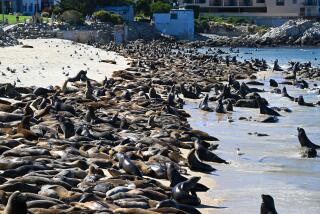Where Swallows Return : They, Other Birds Can Be Found at San Juan Creek, Not Mission
- Share via
SAN JUAN CAPISTRANO — When crowds gather in front of Mission San Juan Capistrano every March 19, vainly searching for the mythical swarm of swallows coming home, Monique Rea chuckles to herself.
*
The South Coast Audubon Society member knows where the swallows can be found, and it’s not on a busy downtown street corner like the one where the mission sits.
Serving as a wilderness hotel for migratory birds, a lush, four-acre area along San Juan Creek is where the swallows really return, and since last year the local Audubon chapter has been its caretaker.
“If you really want to see swallows, come to the creek,” Rea said, pointing to one of the first swallows of spring, perched on a budding willow tree branch.
Dozens of bird species live year-round in this small avian oasis, tucked between a residential community and two schools in east San Juan Capistrano.
To preserve the natural bird habitat, Audubon volunteers toil throughout the year on the city-owned land, tearing out 12-foot-high reeds that choke out native creek-side vegetation, pulling man-made rubbish from the creek and planting new trees.
“When you appreciate nature, you don’t want to see it deteriorate,” said Ken Fortune, a South Coast Audubon board member. “There’s a very special satisfaction to seeing this creek improve before our eyes.”
San Juan Creek is one of two major waterways in South County. It is fed by the rugged hills of Cleveland National Forest and flows for about 20 miles past large stretches of grassland before emptying into the Pacific Ocean.
Greedy for water in Southern California’s semiarid climate, vegetation grows thickly along the creek. Live oak, willow and sycamore trees attract a rich, diverse array of wildlife, from raccoons to scrub jays, hawks, grosbeaks and at least two varieties of swallow.
But in recent years, all wild things living along the creek have been threatened by arundo donax, a non-native reed with explosive growth characteristics that dominates most other forms of vegetation.
“It absolutely engulfs an area,” said Orange County Regional Parks Director Tim Miller. “It crowds out all the other, native plants, and what happens is that the food sources for birds and other animals vanish. This stuff is so invasive, it’s like a true weed.”
Much of the reed eradication will be done by a developer in exchange for the city’s recent approval of a 400-unit housing project. In partnership with the city, the Audubon Society clears off the rest and oversees the overall rehabilitation of the area.
“This is the type of public/private partnership we love to accommodate in San Juan,” said Ron Sievers, city director of public lands. “It’s not just people putting trees in holes. Projects like this put stewardship of the land in the hands of people. We appreciate the Audubon’s work tremendously.”
The work is worth the effort because the wilderness area is accessible to people, particularly the two neighboring schools, Rae said.
A clear, sunny day recently brought Bill Vanlear, a teacher at St. Margaret’s Episcopal School, and his geometry class to the creek banks, drawing pads in hand.
“We’re here to learn about shapes,” he said, turning to a student, who added, “and nature is a good place to learn geometry.”
Many nearby residents walk through the area on a bike path that follows the creek down to the beach. Several residents and an occasional school class come by regularly and help Audubon members with their creek rehabilitation projects.
Bikers passing by will stop and lend a hand. A local nursery specializing in native plants sells to South Coast Audubon at a discount. When a recent planting was done, elementary school students drew colorful signs to mark the area, with slogans such as, “If you tread, I’m dead.”
“Improving an urban habitat like this one is a tremendous benefit to everyone,” Audubon’s Fortune said. “We want to share our joy of nature with the community.”
The project is an offshoot of the Audubon Society’s Birds in the Balance program, a national effort to re-establish bird habitat by cleaning up the country’s streams and rivers.
“It will take a lot of vision and effort,” Fortune said. “We’re starting right here.”






